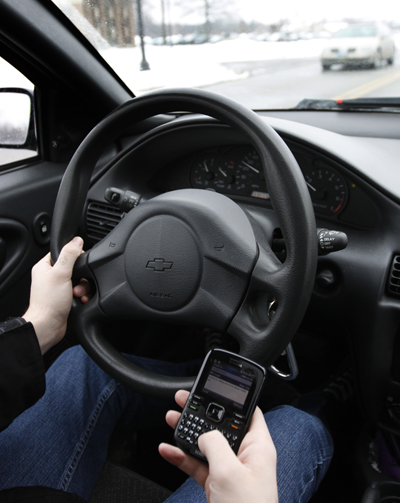AAA pushes for cautious driving

February 1, 2011
There is no national law against texting and driving, but AAA East Central’s legislative priorities for 2011in Ohio include texting bans and teen driver safety, according to a press release.
“Last year showed many states’ strong commitment to traffic safety, as nearly a dozen states enacted laws banning texting while driving,” Brian Newbacher, AAA East Central director of public affairs, said in a press release. “AAA is working with legislators and other safety advocates to support legislation in Ohio in 2011 that will make roads safer by banning texting for drivers of all ages.”
However, in an interview, Newbacher said no bill has been written yet.
“But one could [be] made soon because distracted driving is a major cause of crashes. It causes 20 percent of all crashes,” he said. “We have and will support any new bill that comes out, and we educate our members about the dangers of texting and driving.”
Bevi Powell, director of communications for AAA East Central, said efforts are concentrated on young drivers because they lack experience and are more likely to take the risk of texting while driving.
“Young drivers text because they feel the action will only take seconds and will not affect their safety. But in reality, they are taking their eyes off the road, and that is always dangerous,” Powell said.
Jess Parson, freshman exploratory major, said she doesn’t text when she’s actually driving.
“I text when I’m stopped at stop signs or red lights,” Parson said. “I think it’s dangerous to text while actually moving, and I don’t want to wreck my car.”
Some municipalities in Ohio have created their own laws dealing with cellular phone use.
According to drivinglaws.org’s “Ohio Driving Laws and Cell-Phone Legislatior,” three cities currently have laws against texting and driving. In Brooklyn, Ohio, the law states that a driver cannot use a mobile telephone unless the driver maintains both hands on the wheel. If the law is broken, the fine can run from $35 to $100.
In North Olmsted, there is a $75 fine for a person using a cell phone while driving even when using a hands-free device. Cleveland voted for a similar ban on text messaging in 2009—when the law goes into effect, a first-time offender will be fined $100.
Mike Richardson, a supervisor at the Cleveland Police Department, said people who text and drive can be pulled over.
“We can see it when they do it,” Richardson said. “I’ve even seen a guy once driving with his knees and texting with his hands.”
Kent State police officer Michquel Penn said even though texting and driving is not illegal in Kent, it is still a major problem. The world is in a technology age, but people need to be more cautious, she said.
“If you have to text someone back, just pull over and do it,” Penn said. “Some parents are even asking their children to put their phones in the trunk while they drive, and that’s a good idea.”
Elizabeth Judd, senior visual communication design major, said it depends on her phone’s keypad if she texts while driving.
“I used to text and drive when I had my old phone because I was comfortable with the keys and able to keep my eyes on the road,” Judd said. “I have a new phone now, so I don’t text and drive anymore.”
Other issues at the top of AAA’s agenda include establishing booster seat laws in Arizona, Florida and South Dakota and improving primary seat belt laws in 19 states.
According to the press release, AAA started its new website, TeenDriving.AAA.com, to help parents teach teens how to drive when they are planning to receive their driver’s permit and license.
“As Ohio grapples with another year of budget challenges, safety improvements are a low-cost way that legislators can make the state a better place to live,” Newbacher said in the press release. “Laws that reduce crashes, injuries and deaths can help reduce governments’ medical and emergency response costs.”
Contact Maura Zurick at [email protected].
























